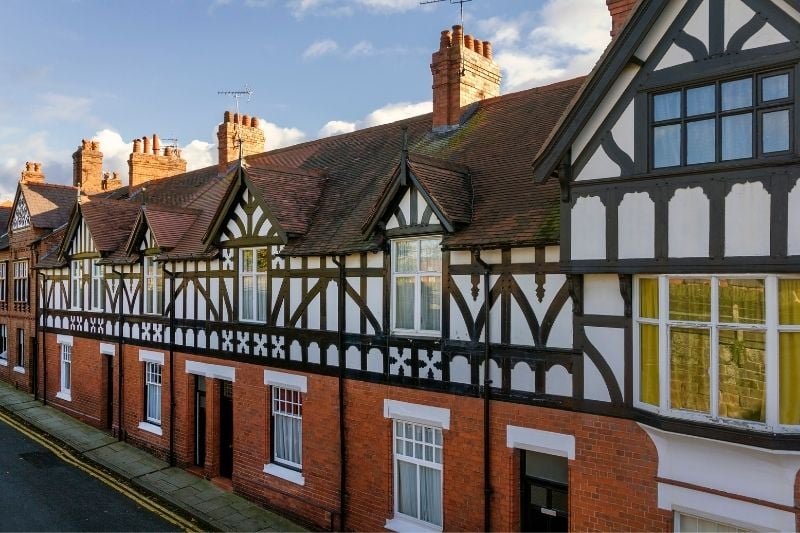Tudor Style Home: Design your home with historic elegance and classic architectural details

Tudor style housesadds a historic touch to modern living spaces with a deeply rooted architectural approach that dates back to the 15th and 16th centuries in England. Characterized by sloping roofs, wooden beams and stone structures, these houses offer elegance and durability at the same time.
In this content you will learn many details from the characteristic features of the Tudor style to how you can adapt it to your home.
History of Tudor Style Homes
History of a Tudor style houseIt dates back to the Tudor dynasty, which emerged in England towards the end of the 15th century. This period, which lasted from 1485 to 1603, is known as a time when English architecture experienced a transition from Gothic elements to a simpler but elegant style.
Origin of Tudor Architecture During this transitional period it was shaped by the combination of local building techniques in England and influences from various parts of Europe.
Tudor style homes are best known for the use of wooden beams on the exterior and support by stone materials. In addition, these houses were considered indicators of social status.
While wealthy aristocrats lived in grand Tudor mansions, more modest Tudor houses were built in the villages. In fact, both types of buildings share the same characteristic elements; Sloping roofs, small window structures and large stone fireplaces are among the prominent features of this style.

Typical features of Tudor houses
Tudor-style homes are characterized by certain architectural elements that stand out at first glance. One of the most striking features of these houses is the wooden beams on the outside.
These dark cross-patterned beams create a visual contrast on the exterior of the home, a feature that makes Tudor homes instantly recognizable. In addition to wooden beams, stone materials commonly used in homes also provide durability and strength. Features of Tudor Houses Typically, stone structures are used on the lower floors and wooden structures on the upper floors.
Another important element is Tudor Architecture Details The sloping and pitched roof constructions are listed below. These roofs prevent rain and snow from accumulating and add volume to the building.
Typical features of this style are small panes of glass in windows and often diamond-shaped windows. Large fireplaces and wooden details stand out in the interior.
Large wooden tables and classic tables are mainly used in the dining room Dining room set Elements such as these are important decorative details that reflect the elegance of the Tudor style.

Tudor style interior
Tudor style home decor also offers elegance with its strong architectural lines and striking interior details. This style is known for heavy wooden furniture, dark tones and rich use of natural materials.
Here are some features that characterize the interiors of Tudor-style houses:
Large stone fireplaces
In Tudor-style houses FireplacesIt plays a central role both functionally and aesthetically. Large fireplaces with stone or brick details are not only a source of heat in the home, but are also one of the most eye-catching decorative elements in the room.
These fireplaces are decorated with dark wooden frames or carved stone motifs. In the living rooms, the seating areas created around the fireplace reflect the traditional family atmosphere of the Tudor style.
Diamond-shaped glasses in windows
One of the most iconic details of Tudor style homes, diamond-shaped glass windows. These wood-framed windows, usually made of small panels, give the interior a nostalgic atmosphere.
These types of windows allow natural light to gently enter the room and make the room appear warmer. Applying this style of window in modern homes can create an eye-catching detail in the interior while maintaining the classic atmosphere of the Tudor style.
Cast iron and metal details
Tudor style home decor, cast iron and metal accessories occupy an important place. Wrought iron is mainly used in door handles, iron frames on windows and lighting elements.
While these metal details reflect the hard and solid character of the Tudor style, they also add a strong aesthetic accent. Metal chandeliers, iron accessories in front of the fireplace and fine workmanship of the window coverings complete the elegance of the Tudor style.
Use of stone and wood on floors
Stone or wood are used for the interior floors of Tudor-style houses. Stone floorsIt is particularly commonly used in areas such as entrance halls and kitchens, as it gives the room a solid and natural structure.
Wooden floors are preferred in living rooms and bedrooms. Solid wood floors make the room inviting. The combination of stone and wood enhances the durable look of Tudor-style homes.

How to decorate a Tudor style house?
Add elegance with dark colors and natural materials
The basis of decoration in the Tudor style, dark colors and creates natural materials. This style features hues such as deep brown, dark green, burgundy and navy blue.
Tudor style color paletteThese shades add elegance and splendor to the room and harmonize with materials such as natural wood and stone. Creating depth through the use of dark colors is a way to create a strong atmosphere without weighing down the atmosphere of the room.
Dark tones can be used to create warmth, especially in large areas such as living rooms and bedrooms. After choosing these shades for furniture and walls, you can use bright accessories to add balance to the room.
Neutral tones such as cream, beige and gray combined with dark colors Decoration ideas Provides a more balanced view. You can also bring the historical elegance of the Tudor style into your home with curtains, cushions and rugs in dark tones.
A classic touch with wooden furniture
Tudor style decoration Wooden furniture It is an indispensable element. Furniture made from solid and dark wood materials adds both durability and elegance to your home.
Tudor-style furniture, especially decorated with hand-carved details, is an excellent choice for bringing the historical atmosphere into your home. The natural texture and heavy look of wood give the room a classic character.
You can choose a large wooden table for the dining room and emphasize the Tudor style with detailed engravings on the chairs and cabinets. Likewise, you can highlight the splendor of this style by using wooden furniture in the bedroom.
Particularly, Bed and base Using solid wood in your choices will create a lasting feeling of luxury in the room. With wooden coffee tables, shelves and display cabinets, you can incorporate this historical elegance into every corner of your home.
Choose classic Tudor chandeliers for lighting
In Tudor style interior design, lighting plays a crucial role in creating atmosphere and adding an aesthetic touch. Tudor style lightingis characterized by large, eye-catching chandeliers decorated with metal details. Classic Tudor chandeliers are made of bronze, wrought iron or gold-colored metals and these materials add a timeless elegance to the room.
Ideal for halls with high ceilings or large entrance halls Decorative chandelier ideas You can choose. In the Tudor style, chandeliers often have elegant curves and candle-shaped bulbs.
This type of lighting gives the room a nostalgic atmosphere and creates an eye-catcher. You can achieve a historical aesthetic by accentuating the classic Tudor style in your modern living spaces with these chandeliers.
You can combine these chandeliers with stone walls or wooden furniture to match the overall decoration of the room.
Complete Tudor elegance with decorative accessories
Choosing the right accessories is very important to fully reflect the spirit of Tudor style home decoration. Tudor style accessoriesimpresses with elegant and historical details. Handcrafted ceramic vases, metal candlesticks, velvet curtains and leather-bound books are perfect to highlight the grandeur of the Tudor style. decorative Tudor details between.
When selecting accessories, the focus is on natural materials and detailed workmanship. Antique figurines, mirrors with wooden frames or bronze sculptures to place on mantels complementary productshelps you bring Tudor elegance to every corner of your home.
You can incorporate the nostalgic texture of this style into modern living spaces by using handmade tapestries or paintings with historical motifs on the walls.

Tudor Style Home Frequently Asked Questions
What does Tudor mean?
Tudor, It is the name of a dynasty that ruled in English history between 1485 and 1603.. The Tudor dynasty is an important turning point in the social, cultural and political development of England.
During this time it was primarily King Henry VII. It begins with Henry VIII’s victory at the Battle of Bosworth and his accession to the throne and ends with the death of Queen Elizabeth I.
Tudor architecture is often known for its timber-beamed facades, gable roofs, stone walls and elegant window details. Tudor-style homes and decorations are characterized by architectural features that provide a historical and nostalgic aesthetic.

You might be interested in:
Minimalist bedroom decoration: Peaceful spaces where simplicity and elegance meet
Timeless Elegans: Synthesis of modern and classic with neoclassical decoration
What is country style? How to decorate a country house?
Houses of the future: What is biophilic design and how can it be implemented?
City-themed home decoration tips




